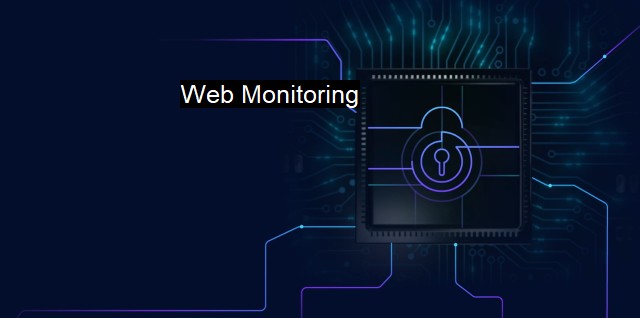What is Web Monitoring?
Web Monitoring: Safeguarding Your Cybersecurity and Antivirus with an Essential Tool
Web monitoring, in the context of cyber security and antivirus, involves overseeing the functionality and integrity of a website or a web application to ensure it performs optimally and safely. It consists of several components, including website optimization, load time, transaction and network security monitoring, which, together, work towards providing a secure browsing environment for end-users. In the evolving digital scape, the importance of web monitoring for cyber security becomes increasingly vital.One crucial aspect of web monitoring worthy of discussion pertains to traffic monitoring. This procedure entails the screening and examination of all incoming and outgoing data from one's website or network. Through traffic monitoring, administrators can identify unexpected or odd patterns reflecting potential threats such as Denial-of-service (DoS) attacks or unauthorized access attempts. If unusual activity is detected, immediate actions can quickly be taken to investigate and limit damage.
Alongside traffic monitoring, vulnerability scan is also instrumental in web monitoring. It involves auditing a network's system or individual websites for any potential loopholes and security risks that could make them an easy target for cyber threats including malware, viruses, ransomware, and other sophisticated threats. Upon detecting these vulnerabilities, either automated or manual frameworks can be followed to fix them, strengthening the security of the network or website.
The use of antiviruses forms a propensity within web monitoring. Antivirus software is now frequently employed as an integral component of web application firewalls (WAFs) and intrusion prevention systems (IPS) that defend against specific web-based attacks. These software types are designed to automate threat detection and response, enabling real-time security and maintaining the stability and security of networks and websites.
Web monitoring also encapsulates the necessary activity widely known as patch management. It’s a strategy for managing updates of information systems, including the acquisition, testing, and installation of multiple 'patches' (software and system updates) designed to correct known vulnerabilities. Timely patching reduces the potential exploitation of these vulnerabilities, equipping the system with robust defense mechanisms.
Web monitoring covers backup and recovery capabilities. These capabilities ensure that critical data is frequently backed up and stored securely. In the event of a cyber attack, data can easily be restored, minimally impacting business continuity. This data backup solution compliments the overall framework of web monitoring, acting as a safety net if other prevention mechanisms miss a threat.
Web monitoring services extend to defining and enforcing user access policies as well. By clearly stating who can access what part of the system or website, access restrictions act as robust preventative barriers to potential malicious actions. This precautionary principle enables organizations to ensure that sensitive information remains safeguarded against the prying eyes of cybercriminals.
To sum it up, web monitoring serves as a frontline defense against cyber assaults. As the digital world swells with data flowing in from various sources, organizations should robustly monitor their systems and websites concerning cyber security. By utilizing established practices like traffic monitoring, vulnerability scanning, antivirus usage, patch management, backup and recovery strategies, and access control policies, web monitoring can significantly boost cyber security defenses.
Web monitoring aids in the immediate identification of possible threats, allowing organizations to respond timely and minimize associated risk. With a proactive approach to detecting security vulnerabilities, web monitoring can dramatically improve security postures, assuring the integrity, availability, and reliability of web services endangered by cyber threats. As the digital space continues to evolve, it is wise to remember that multi-layered defense strategies, including advanced web monitoring, will forever remain a cornerstone of cyber security and antivirus. This approach offers the most comprehensive protection against an array of cyber hazards, thereby fostering a stronger, healthier, and safer digital environment.

Web Monitoring FAQs
What is web monitoring and why is it important for cybersecurity?
Web monitoring refers to the process of tracking and analyzing online activities and behaviors to detect potential threats and vulnerabilities in a network. It is a crucial part of cybersecurity, as it helps identify and prevent cyberattacks from infiltrating a system.What are the benefits of using a web monitoring tool for antivirus protection?
Web monitoring tools can help antivirus software detect and block suspicious activities and behavior on websites and web applications. This improves the accuracy and effectiveness of the antivirus protection, as it can identify and neutralize threats before they can infiltrate a system.What types of cyber threats can web monitoring detect?
Web monitoring can detect a wide range of cyber threats, including malware infections, phishing scams, data breaches, unauthorized access attempts, and other suspicious activities that could compromise the security of a network.What features should I look for in a web monitoring tool for cybersecurity?
Some of the key features to consider when choosing a web monitoring tool for cybersecurity include real-time monitoring and alerts, advanced threat detection capabilities, customizable dashboards and reports, and integration with other security tools and technologies. It is also important to consider factors such as ease of use, scalability, and customer support when evaluating web monitoring solutions.| | A | | | B | | | C | | | D | | | E | | | F | | | G | | | H | | | I | | | J | | | K | | | L | | | M | |
| | N | | | O | | | P | | | Q | | | R | | | S | | | T | | | U | | | V | | | W | | | X | | | Y | | | Z | |
| | 1 | | | 2 | | | 3 | | | 4 | | | 7 | | | 8 | | |||||||